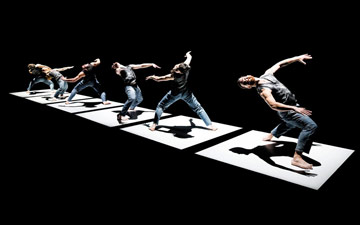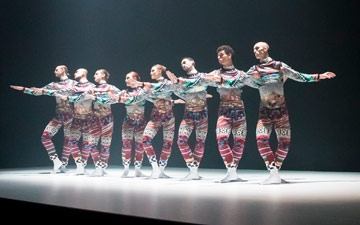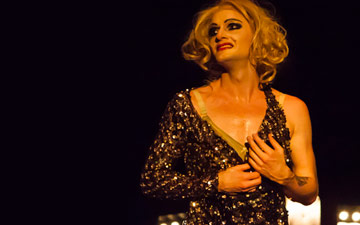
© Clive Barda. (Click image for larger version)
National Dance Company Wales/Music Theatre Wales
Pascal Dusapin’s Passion
★★★★✰
London, Queen Elizabeth Hall
13 October 2018
ndcwales.co.uk
www.southbankcentre.co.uk
Pascal Dusapin’s dance opera Passion is a minimalist affair. There are no ornate sets or costumes, no crowds of characters or elaborate plotlines to consume them. Instead we’re presented with a snapshot of two anonymous lovers – Him and Her – mourning their separation in the wake of her death. The show, more focused on capturing their distress than recounting the details of their tragedy, plays out against a streamlined, almost stark stage design of sleek black and yellow.

© Clive Barda. (Click image for larger version)
Dusapin debuted the production in France in 2008, and has recently teamed up with Music Theatre Wales, National Dance Company Wales and the London Sinfonietta for a reprisal on the UK stage. It borrows its themes from the myth of Orpheus, who journeys to the underworld to rescue his beloved Eurydice from death’s door only to see her snatched away forever after he breaches the conditions of her release. Baritone Johnny Herford and soprano Jennifer France take on the leading roles, while five dancers from National Dance Company of Wales form a Greek chorus that animates the couple’s despair.
The action doesn’t climb the traditional arc of a plot but instead persists as a steady hum of tension, Herford and France taking it in turns to intone individually about their plight. The physicality of their performance is impressive: their singing remains sound as they crumble to the floor in desolation, and even as they’re flipped and flung by the dancers. In one scene, our heroine performs an aria while wrestling away from the shackles of a mob; in another her lover succumbs to a violent, warbling fit, tearing at his hair and skin.
The dancing is contemporary and furnished with a tidy elegance that complements these moments of theatricality. It follows the simmering mood in its constancy, treading the same blueprints repeatedly: pops of energy – sudden swivels, shattered postures – followed up with stretchy, flowing poses. The best phrases engage with the sparse props available: gambols on the floor-to-ceiling ladder bisecting the stage, the performers dangling between its rungs; a haunting display where one is seized by spectres hidden in a billowing marigold curtain. There are some lovely duets between the men and women of the group, and the cast as a whole strikes several vivid tableaux, including one in which they envelop France’s curved body, agents of chaos claiming her as their own.
Dusapin’s textured score pitches live orchestral numbers alongside off-stage vocals and various instrumental recordings. These latter compositions, while inspiring an interesting layering effect, sound tinny at times, thin in tone and sound quality. Far more robust are the swerving strings of the live violinists, which send the dancers spinning, and the Arcadian plucks of Alexander Rider on the harp.

© Clive Barda. (Click image for larger version)
These soaring moments aren’t quite enough to stave off a sense of monotony, however. With few changes in tone and no discernible climax, Passion’s 80 minutes eventually start to feel samey. The protagonists rarely interact, meaning we’re granted few glimpses into the ardour or chemistry of their relationship. But if the mood seems one-note, limited to a slow-burning strain, it’s also convincing in its communication of suffering. We might not know the particulars of their grief, but we can certainly grasp the dread of it.

















You must be logged in to post a comment.